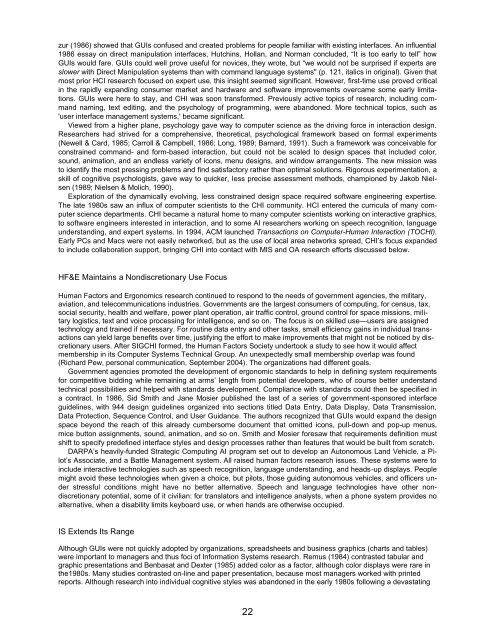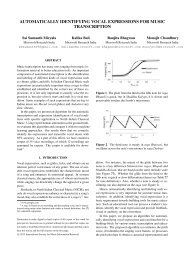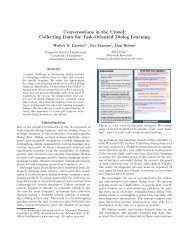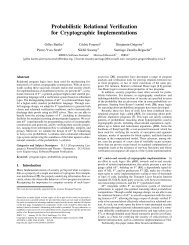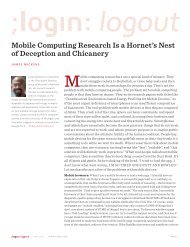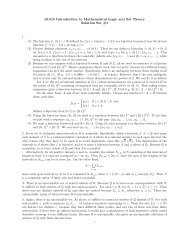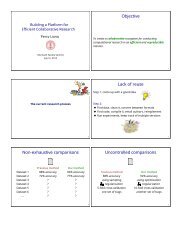A Moving Target—The Evolution of Human-Computer Interaction
A Moving Target—The Evolution of Human-Computer Interaction
A Moving Target—The Evolution of Human-Computer Interaction
You also want an ePaper? Increase the reach of your titles
YUMPU automatically turns print PDFs into web optimized ePapers that Google loves.
zur (1986) showed that GUIs confused and created problems for people familiar with existing interfaces. An influential<br />
1986 essay on direct manipulation interfaces, Hutchins, Hollan, and Norman concluded, “It is too early to tell” how<br />
GUIs would fare. GUIs could well prove useful for novices, they wrote, but “we would not be surprised if experts are<br />
slower with Direct Manipulation systems than with command language systems" (p. 121, italics in original). Given that<br />
most prior HCI research focused on expert use, this insight seemed significant. However, first-time use proved critical<br />
in the rapidly expanding consumer market and hardware and s<strong>of</strong>tware improvements overcame some early limitations.<br />
GUIs were here to stay, and CHI was soon transformed. Previously active topics <strong>of</strong> research, including command<br />
naming, text editing, and the psychology <strong>of</strong> programming, were abandoned. More technical topics, such as<br />
'user interface management systems,' became significant.<br />
Viewed from a higher plane, psychology gave way to computer science as the driving force in interaction design.<br />
Researchers had strived for a comprehensive, theoretical, psychological framework based on formal experiments<br />
(Newell & Card, 1985; Carroll & Campbell, 1986; Long, 1989; Barnard, 1991). Such a framework was conceivable for<br />
constrained command- and form-based interaction, but could not be scaled to design spaces that included color,<br />
sound, animation, and an endless variety <strong>of</strong> icons, menu designs, and window arrangements. The new mission was<br />
to identify the most pressing problems and find satisfactory rather than optimal solutions. Rigorous experimentation, a<br />
skill <strong>of</strong> cognitive psychologists, gave way to quicker, less precise assessment methods, championed by Jakob Nielsen<br />
(1989; Nielsen & Molich, 1990).<br />
Exploration <strong>of</strong> the dynamically evolving, less constrained design space required s<strong>of</strong>tware engineering expertise.<br />
The late 1980s saw an influx <strong>of</strong> computer scientists to the CHI community. HCI entered the curricula <strong>of</strong> many computer<br />
science departments. CHI became a natural home to many computer scientists working on interactive graphics,<br />
to s<strong>of</strong>tware engineers interested in interaction, and to some AI researchers working on speech recognition, language<br />
understanding, and expert systems. In 1994, ACM launched Transactions on <strong>Computer</strong>-<strong>Human</strong> <strong>Interaction</strong> (TOCHI).<br />
Early PCs and Macs were not easily networked, but as the use <strong>of</strong> local area networks spread, CHI’s focus expanded<br />
to include collaboration support, bringing CHI into contact with MIS and OA research efforts discussed below.<br />
HF&E Maintains a Nondiscretionary Use Focus<br />
<strong>Human</strong> Factors and Ergonomics research continued to respond to the needs <strong>of</strong> government agencies, the military,<br />
aviation, and telecommunications industries. Governments are the largest consumers <strong>of</strong> computing, for census, tax,<br />
social security, health and welfare, power plant operation, air traffic control, ground control for space missions, military<br />
logistics, text and voice processing for intelligence, and so on. The focus is on skilled use—users are assigned<br />
technology and trained if necessary. For routine data entry and other tasks, small efficiency gains in individual transactions<br />
can yield large benefits over time, justifying the effort to make improvements that might not be noticed by discretionary<br />
users. After SIGCHI formed, the <strong>Human</strong> Factors Society undertook a study to see how it would affect<br />
membership in its <strong>Computer</strong> Systems Technical Group. An unexpectedly small membership overlap was found<br />
(Richard Pew, personal communication, September 2004). The organizations had different goals.<br />
Government agencies promoted the development <strong>of</strong> ergonomic standards to help in defining system requirements<br />
for competitive bidding while remaining at arms’ length from potential developers, who <strong>of</strong> course better understand<br />
technical possibilities and helped with standards development. Compliance with standards could then be specified in<br />
a contract. In 1986, Sid Smith and Jane Mosier published the last <strong>of</strong> a series <strong>of</strong> government-sponsored interface<br />
guidelines, with 944 design guidelines organized into sections titled Data Entry, Data Display, Data Transmission,<br />
Data Protection, Sequence Control, and User Guidance. The authors recognized that GUIs would expand the design<br />
space beyond the reach <strong>of</strong> this already cumbersome document that omitted icons, pull-down and pop-up menus,<br />
mice button assignments, sound, animation, and so on. Smith and Mosier foresaw that requirements definition must<br />
shift to specify predefined interface styles and design processes rather than features that would be built from scratch.<br />
DARPA’s heavily-funded Strategic Computing AI program set out to develop an Autonomous Land Vehicle, a Pilot’s<br />
Associate, and a Battle Management system. All raised human factors research issues. These systems were to<br />
include interactive technologies such as speech recognition, language understanding, and heads-up displays. People<br />
might avoid these technologies when given a choice, but pilots, those guiding autonomous vehicles, and <strong>of</strong>ficers under<br />
stressful conditions might have no better alternative. Speech and language technologies have other nondiscretionary<br />
potential, some <strong>of</strong> it civilian: for translators and intelligence analysts, when a phone system provides no<br />
alternative, when a disability limits keyboard use, or when hands are otherwise occupied.<br />
IS Extends Its Range<br />
Although GUIs were not quickly adopted by organizations, spreadsheets and business graphics (charts and tables)<br />
were important to managers and thus foci <strong>of</strong> Information Systems research. Remus (1984) contrasted tabular and<br />
graphic presentations and Benbasat and Dexter (1985) added color as a factor, although color displays were rare in<br />
the1980s. Many studies contrasted on-line and paper presentation, because most managers worked with printed<br />
reports. Although research into individual cognitive styles was abandoned in the early 1980s following a devastating<br />
22


